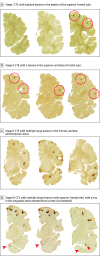Neuropathologic and Clinical Findings in Young Contact Sport Athletes Exposed to Repetitive Head Impacts
- PMID: 37639244
- PMCID: PMC10463175
- DOI: 10.1001/jamaneurol.2023.2907
Neuropathologic and Clinical Findings in Young Contact Sport Athletes Exposed to Repetitive Head Impacts
Abstract
Importance: Young contact sport athletes may be at risk for long-term neuropathologic disorders, including chronic traumatic encephalopathy (CTE).
Objective: To characterize the neuropathologic and clinical symptoms of young brain donors who were contact sport athletes.
Design, setting, and participants: This case series analyzes findings from 152 of 156 brain donors younger than 30 years identified through the Understanding Neurologic Injury and Traumatic Encephalopathy (UNITE) Brain Bank who donated their brains from February 1, 2008, to September 31, 2022. Neuropathologic evaluations, retrospective telephone clinical assessments, and online questionnaires with informants were performed blinded. Data analysis was conducted between August 2021 and June 2023.
Exposures: Repetitive head impacts from contact sports.
Main outcomes and measures: Gross and microscopic neuropathologic assessment, including diagnosis of CTE, based on defined diagnostic criteria; and informant-reported athletic history and informant-completed scales that assess cognitive symptoms, mood disturbances, and neurobehavioral dysregulation.
Results: Among the 152 deceased contact sports participants (mean [SD] age, 22.97 [4.31] years; 141 [92.8%] male) included in the study, CTE was diagnosed in 63 (41.4%; median [IQR] age, 26 [24-27] years). Of the 63 brain donors diagnosed with CTE, 60 (95.2%) were diagnosed with mild CTE (stages I or II). Brain donors who had CTE were more likely to be older (mean difference, 3.92 years; 95% CI, 2.74-5.10 years) Of the 63 athletes with CTE, 45 (71.4%) were men who played amateur sports, including American football, ice hockey, soccer, rugby, and wrestling; 1 woman with CTE played collegiate soccer. For those who played football, duration of playing career was significantly longer in those with vs without CTE (mean difference, 2.81 years; 95% CI, 1.15-4.48 years). Athletes with CTE had more ventricular dilatation, cavum septum pellucidum, thalamic notching, and perivascular pigment-laden macrophages in the frontal white matter than those without CTE. Cognitive and neurobehavioral symptoms were frequent among all brain donors. Suicide was the most common cause of death, followed by unintentional overdose; there were no differences in cause of death or clinical symptoms based on CTE status.
Conclusions and relevance: This case series found that young brain donors exposed to repetitive head impacts were highly symptomatic regardless of CTE status, and the causes of symptoms in this sample are likely multifactorial. Future studies that include young brain donors unexposed to repetitive head impacts are needed to clarify the association among exposure, white matter and microvascular pathologic findings, CTE, and clinical symptoms.
Conflict of interest statement
Figures



References
Publication types
MeSH terms
Grants and funding
- RF1 AG057902/AG/NIA NIH HHS/United States
- R21 HD089088/HD/NICHD NIH HHS/United States
- RF1 NS122854/NS/NINDS NIH HHS/United States
- U01 NS086659/NS/NINDS NIH HHS/United States
- R01 NS078337/NS/NINDS NIH HHS/United States
- K23 AG046377/AG/NIA NIH HHS/United States
- R56 NS078337/NS/NINDS NIH HHS/United States
- U01 NS093334/NS/NINDS NIH HHS/United States
- F32 NS096803/NS/NINDS NIH HHS/United States
- P30 AG013846/AG/NIA NIH HHS/United States
- U54 NS115266/NS/NINDS NIH HHS/United States
- R01 AG061028/AG/NIA NIH HHS/United States
- UL1 TR001430/TR/NCATS NIH HHS/United States
- F31 NS127449/NS/NINDS NIH HHS/United States
- K23 NS102399/NS/NINDS NIH HHS/United States
LinkOut - more resources
Full Text Sources
Medical

